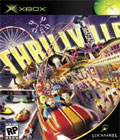Crazy Coasters!
Working on Thrillville, one of the most satisfying things to do is to build the craziest, curviest, fastest, wickedest coasters you've ever seen. The kind of coaster that gets that thrill meter (some might call it a "nausea meter" - depending on how much your stomach can take) through the roof. Over the past few months, I've gained a reputation among the staff here for creating some of wickedest rides of anyone - and here's how I do it.
First, what's the most important thing a coaster has to do?
...OK, I suppose "stay on the rails" is the most important... But what's the second most important?
Go really fast.
To do this, I build the coaster as high as I possibly can, right at the start. I start out with a slow ascent, because the anticipation always makes it better. Once at the top, I drop it all the way down to ground level. Straight down, preferably. This gives the coaster a good boost of initial speed, which is needed up front to carry through the rest of it.
Secondly, I go into the advanced settings on each coaster, and dial up the lift and launch speeds to the max.
The third key to speed is relative motion. If you're going a couple hundred miles an hour over an open desert, you can't tell how fast you're going - at least not until that cactus whips past you at mach 1.
The key here is getting the coaster track to go as close as it can to anything and everything. I buzz the drink stalls, whip around the Ferris wheel, and barnstorm the park guests.
Best of all is getting the track as close to itself as possible. Is there a big loop? I'll turn that sucker around and go right through it, threading the needle.
This is my current favorite coaster trick - check it out when you get the game: Try putting a dozen helix pieces together to create a long spiraling tube that spins the carts around in dizzying circles. Then, at the end, bring that track right back and dive down through the center of the tornado. If your guests aren't sick by the time that's done, then you need to lower the price on greasy food.
But the most important thing to do is to experiment. Try every combination of crazy pieces you can think of.
We have this blueprint testing zone where you can try out your madcap ideas in an open area. It has a much taller height limit for your coasters. Now, I don't mean that the wooden clown telling you "You Must Be This Tall To Ride This Ride!" has raised his outstretched hand a few feet higher. I mean that you can build the most ridiculously tall, skyscraping tower of thrills imaginable.
Remember: the taller it is, the longer the drop. And the longer the drop, the faster that sucker's gonna go...
So try out your crazy ideas, because practice makes perfect. I could tell you how to build my personal favorite coaster...but the best coasters to ride are always the ones you make yourself.
By Cameron Suey, Script Writer/International Production Lead at LucasArts
More articles about Thrillville











 Thrillville combines elements of simulation, party games and social interaction like nothing before it, all in one of the most console-friendly theme park titles ever to be released. Its charming, laugh-out-loud story centers around you and the theme park youve inherited from your eccentric Uncle Mortimer. Only by keeping your guests happy and completing most of the hundreds of missions they present can you stave off the threat posed by the nefarious Globo-Joy corporation.
Thrillville combines elements of simulation, party games and social interaction like nothing before it, all in one of the most console-friendly theme park titles ever to be released. Its charming, laugh-out-loud story centers around you and the theme park youve inherited from your eccentric Uncle Mortimer. Only by keeping your guests happy and completing most of the hundreds of missions they present can you stave off the threat posed by the nefarious Globo-Joy corporation.





